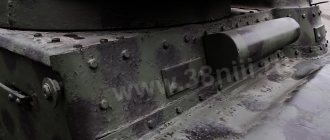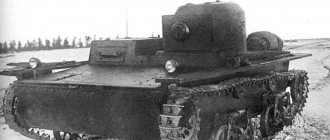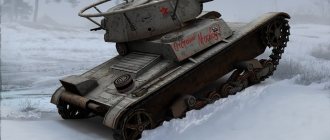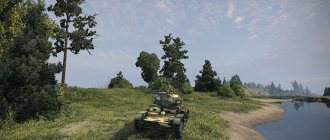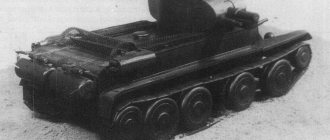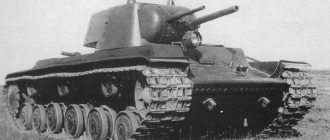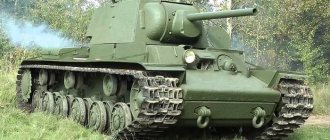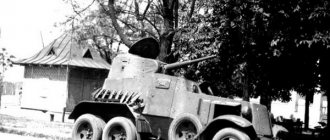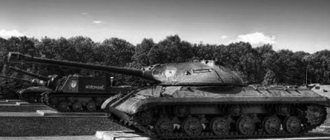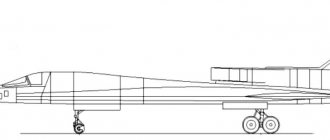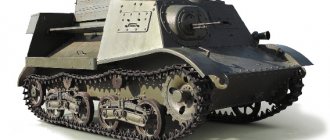The T-90 Vladimir is a main battle tank created in the late 1980s. It is essentially an almost complete modernization of the T-72B, and was even originally called “T-72B improved.”
In the first decade of the 21st century, it was the world's best-selling new main battle tank.
History of the T-90
In 1989, a deep modernization project for the T-72B was created at the Nizhny Tagil UKBTM, which received the factory designation “Object 188”. In the same year, the tank was sent for testing, which it passed very successfully.
In parallel with Object 188, a more advanced Object 187 was being developed. However, they did not have time to finalize the latter - Object 188 was ordered to be put into service at the end of March 1991, and work on 187 was stopped.
After several improvements, it was decided to put the tank into service in October 1992, giving it the name T-90.
Main goals and objectives
The T-90MS tank is designed to conduct active offensive or defensive combat in conditions of strong opposition from the enemy. His tasks include:
- Supporting motorized rifle units, suppressing and destroying enemy firing points directly on the battlefield;
- Breaking through the enemy's defense system, destroying his artillery;
- Fight against tanks and other enemy armored vehicles;
- Deep raids with the destruction of transport convoys, ammunition depots and equipment in the enemy operational rear;
- Conducting reconnaissance.
Thus, the T-90MS is a flexible and fairly universal means of conducting maneuver warfare.
Tactical and technical characteristics of the tank (TTX)
general information
- Classification – main battle tank;
- Combat weight - 46.5 tons;
- The layout is classic;
- Crew – 3 people;
- Years of operation – since 1992.
Dimensions
- Case length – 6860 mm;
- Length with gun forward – 9530 mm;
- Case width – 3780 mm;
- Height – 2230 mm (on the roof of the tower);
- Base – 4270 mm;
- Track – 2790 mm;
Booking
- Type of armor - combined anti-ballistic;
- Active protection - KOEP Shtora-1/1M;
- Dynamic protection - "Contact-5"
Armament
- Caliber and brand of gun - 125 mm 2A46M;
- Gun type – smoothbore;
- Barrel length - 51 caliber;
- Gun ammunition - 43;
- BH angles: -5..+16 degrees;
- GN angles – 360 degrees;
- Firing range – 5 km;
- Sights – gunner (day): 1G46, gunner (night): Buran-PA,M or “ESSA”, Commander (day/night): T01-KO4;
- Machine guns - 1 × 12.7 mm NSVT or Kord, 1 × 7.62 mm PKT
- Another weapon is Reflex-M.
Design Features
Model of the T-90MS tank
The T-90MS is a tank of a classic layout with a front control compartment, which houses the driver, a middle fighting compartment, “topped” with a turret, where the commander and gunner are located, and a rear engine and transmission compartment. The vehicle is equipped with a combat information and control system, part of which is the Kalina fire control system.
The OMS includes, in particular, the following elements:
- PC PAN "Hawkeye". This panoramic sight, designed for a tank commander, was developed in Belarus. It is installed not only on the T-90MS, but also on the T-72B1MS;
- PNM "Sosna-U". The sight is intended for the gunner, it is possible to use a thermal imaging channel and a laser rangefinder;
- Device for automatic target tracking;
- Stabilizer;
- Device for determining nationality.
The Kalina fire control system makes it possible to implement the “hunter-shooter” principle, which implies the rapid “transfer” of identified priority targets to the gunner. This approach ensures a shot at the enemy immediately after he appears in the gun’s destruction sector.
The “hunter” can be either the commander of a combat vehicle using a panoramic sight or another tank. This ensures tactical interaction on the battlefield. The greatest effectiveness can be achieved by T-90MS units receiving target designations from the T-14 Armata.
In general, this approach coincides with the requirements of the concept of network-centric warfare, which implies constant interaction and complete coordination between all direct participants in the battle.
Type of reservation and protection systems
The rear part of the T-90MS turret with an armored box.
The photo shows a vehicle that has been on display since 2011. The T-90MS tank has combined multi-layer armor of differentiated thickness. Lattice screens are installed on the sides and rear of the tank. The rear part of the turret is additionally covered with an armored box.
Almost the entire tank is covered with 4S22 Kontakt-5 modular dynamic protection elements. This distinguishes the T-90MS from the T-90AM and T-90M, which use the newer DZ 4S23 “Relikt”, the export of which is currently prohibited.
An important feature of the T-90MS (and T-90SM) is the absence of the Shtora system, designed for protection against anti-tank guided missiles, as part of the basic configuration. Its installation can be done at the request of the customer. Considering that the Shtora has already proven its effectiveness during the battles in Syria, most buyers are unlikely to refuse it.
The situation is the same with the active protection complex - it is not present on the T-90MS demonstration models, but it can be installed. True, it is not yet possible to purchase the Afghanit that the T-90M is equipped with. Export tanks are expected to be equipped with Arena-E active protection.
To prevent the tank from being blown up by a mine with magnetic fuses, the SPMZ-2E system is used. Protection against secondary fragments formed during an external impact on the armor is provided by screens made of aramid fabric.
Powerplant, transmission and suspension
The power plant for the T-90MS tank is the V-92S2F multi-fuel diesel engine (original name - V-93). Its test cycle was completely completed in 2017, but it was installed on the T-90SM and T-90AM in 2011. The power of this engine is 1130 horsepower.
Multi-fuel engine V-92S2F
The new engine made it possible to significantly increase the thrust-to-weight ratio and mobility of the T-90SM tank. In the future, it is planned to equip these machines with an even more powerful and modern V-99 engine.
Additionally, an auxiliary diesel generator set is installed on the tank - it is located on the side fender and is designed to supply electricity to on-board equipment when the main engine is turned off.
The transmission design is largely unchanged; the same seven forward and one reverse gears as on the original T-90A are retained. There is an automatic gearshift - mechanisms of this type in ordinary cars are usually called “robot gearbox”; they should not be confused with conventional hydromechanical automatic transmissions.
The suspension, judging by the photographs of the tank, is practically no different from that of the T-90A - an individual torsion bar. The smoothness of the ride can be judged by the results of practical application. Control is carried out using a rotary steering wheel.
Advantages and disadvantages
The T-90MS tank meets all the basic requirements of modern combat, which is due to a number of its positive qualities:
- High level of security. In this parameter, the new vehicle should be ahead of the T-90A, which has proven itself well in Syria;
- Excellent characteristics of the fire control system;
- The level of safety for the crew has increased significantly. The autoloader carousel received additional protection, the rest of the ammunition was spaced out;
- The tank has a high power output, which makes it mobile and maneuverable.
It’s probably too early to talk about the shortcomings, but at least two disadvantages can be noted - insufficient armor penetration of the main types of projectiles and the unfortunate location of the diesel generator set, which is very vulnerable to enemy fire.
It is interesting that although the T 90MS tank has not yet been tested in the United States, American experts have already made various assessments of this combat vehicle, comparing it with the M1A2 Abrams and usually coming to the traditional conclusion about the total superiority of their own equipment.
Electronic equipment
The Irtysh fire control system was inherited from early tanks from its predecessor, the T-80. But the already modified T-90A tank received a new fire control system (FCS) 1A42. It includes an aiming and rangefinder guidance device (combining a laser rangefinder with a sight) and an automatic electronic ballistic computer 1B528-1.
The T01-K04 observation device makes it possible to fire not only from an anti-aircraft machine gun, but also from the main gun. At night, it can operate in both passive and active (with target illumination by an IR illuminator) mode.
In subsequent series, the control system was modernized, and modifications of the AM (SM) tank received the latest Kalina system. This multifunctional complex combines not only sights and computers - it integrates the tank into the electronic battalion control system, increasing the efficiency of interaction with other armored vehicles and infantry.
Thermal imagers of early machines were early models and were significantly inferior to similar foreign ones.
On later series (and some export versions), French-made thermal imagers were installed. For communication, the R-163-50U radio station operating in the VHF range is used. Commander models received, in addition, a shortwave radio with a range of up to 50 km.
Modifications
To date, only one additional modification of the T-90MS tank is known. This is the T-90MSK, the “commander” version of the combat vehicle. It has not yet been demonstrated, but a preliminary agreement on the supply of such tanks has already been reached with India. Apparently, the T-90MSK will differ from the basic modification by an expanded composition of communications equipment and, possibly, an upgraded combat information and control system at the tactical level.
Tank T-90MS during testing
Application
T-90MS or SM tank in Kuwait
T-90MS tanks did not appear on the battlefield for obvious reasons. There is very little information about their tests. It is known that even in the T-90SM version they were successfully tested in Kuwait in desert conditions. In February 2022, videos were published showing live firing with the participation of the T-90MS, but nothing special was shown. Moreover, representatives of the Ministry of Defense subsequently stated that the demonstration was in fact T-90M tanks intended for the Russian army.
This situation may change in the very near future, since the contract with India is on the verge of being signed, and if it is concluded, full-fledged military tests will have to be carried out, information about which will inevitably end up in the press.
Export to other countries and combat use
Figure 5. Russian T-90 in the ranks of the Indian armed forces
The first state to enter into a contract for the supply of Russian T-90s was India. It was thanks to this deal that the plant resumed production in 2001, when funding for the armed forces was sharply reduced and supplies to its own army were suspended. Over the course of 2 years, 124 T-90S (Bhishma) were assembled at Uralvagonzavod, which differed from the Russian version in the absence of a searchlight and the presence of air conditioning.
At the same time, a contract was signed under which a workshop for the assembly of licensed Russian tanks was opened on the basis of the plant for the production of heavy-duty vehicles. Having fulfilled their obligations, in 2006 the parties entered into another agreement, under which Russia pledged to supply another 1,000 armored vehicles to the Indian armed forces. At the moment, Uralvagonzavod has not fully fulfilled its obligations. It is planned that by 2022 the number of T-90s in the Indian troops will reach 2,000.
According to the head of the Ministry of Industry and Trade D. Manturov, in 2022 another large contract was concluded with a representative of a Middle Eastern country. He did not provide exact information about the customer, indicating only that he needed T-90MS models.
In addition to the major Indian deal, Russian tanks are used by the armed forces of other countries around the world:
- Azerbaijan - 100 units.
- Algeria - 367.
- Armenia - 1.
- Vietnam - 64.
- Iraq - 39.
- Syria - 30.
- Turkmenistan - 10.
- Uganda - 44.
The Russian T-90 "Vladimir" is considered to be one of the best tanks in the world. Over the almost 30-year history of its existence, it was able to embody all the best that made up the domestic tank building industry. Despite the fact that a successor, the Black Eagle, has already been developed on its basis, it continues to confidently occupy the place of the main tank of the Russian Armed Forces with a complete lack of prospects for an immediate replacement.
Tank structure
The T-90 hull is welded from armor sheets, the turret of early models is cast. The length of the hull (without a gun) is 6.8 m. Later modifications had welded turrets. The frontal armor of the hull (upper part) is made of combined armor, installed at an angle of 680. The sides, 70-80 mm thick, are vertical, without slope. This is higher than most analogues (although it protects equally poorly from being hit by an armor-piercing projectile).
The sides are covered with rubber-fabric screens, partially with dynamic protection units. For additional protection, it is possible to install anti-cumulative grilles, which have become widespread in the last decade.
In the design of the T-90 turret, combined armor is used to protect the frontal projection, and partially the sides and roof.
The height reaches 2.2 meters, and the T-90 weighs about 46 tons.
The T-90 was equipped with the Shtora active protection system. If it is irradiated by a guidance laser, the Shtora notifies the crew about this and fires aerosol grenades. The resulting smoke screen not only camouflages the tank visually, but also scatters the laser beam.
The first dynamic protection that appeared on the T-90 was designated “Contact-5”. It did not protect against tandem charges and did not improve resistance against armor-piercing shells. The newest model of the Relikt defense complex, which the T-90AM received, reduces the armor penetration of enemy shells by 40% and protects against heavy ATGMs with a tandem charge. In addition, modernized blocks for the Contact system raise its efficiency to almost a “relic” level.
The dense layout has a negative impact on survivability - fuel tanks have to be placed in the fighting compartment. However, in later modifications they were isolated from the crew by steel bulkheads. The automatic loader remains vulnerable - it is located behind the weakly protected side directly under the crew. We can say that the commander and weapon operator are sitting on the shots.
Crew accommodation has remained unchanged since the introduction of the T-64. The driver's seat is located in the front center of the body. The gunner is located on the left half of the turret, and the tank commander is located to the right of the gun.
The T-90 inherited the power plant from the T-72.
This is a multi-fuel 12-cylinder diesel engine V-84MS with a volume of 38.8 liters and developing 840 hp. In the T-90A modification, the engine was replaced with an improved version of the B-92, based on the same block. Its power reaches 1000 hp. With. The transmission is 7-speed and includes separate planetary gearboxes. Hydraulic drives are used to facilitate control. The T-90 has a torsion bar suspension and hydraulic shock absorbers.
